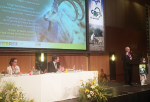The twenty-eighth meeting of the Animals Committee (AC28) of the Convention on International Trade in Endangered Species of Wild Fauna and Flora (CITES) addressed a lengthy agenda, agreeing on guidance with regard to the sustainable trade of snakes, tortoises and freshwater turtles, sharks and rays, and the queen conch.
The Committee's Review of Significant Trade concluded that current trade in polar bears is not harming the species, while Kenya and Namibia agreed to provide the Committee a detailed analysis of trade in African lions to inform the species' listing.
 4 September 2015: The twenty-eighth meeting of the Animals Committee (AC28) of the Convention on International Trade in Endangered Species of Wild Fauna and Flora (CITES) addressed a lengthy agenda, agreeing on guidance with regard to the sustainable trade of snakes, tortoises and freshwater turtles, sharks and rays, and the queen conch. The Committee’s Review of Significant Trade concluded that current trade in polar bears is not harming the species, while Kenya and Namibia agreed to provide the Committee a detailed analysis of trade in African lions to inform the species’ listing.
4 September 2015: The twenty-eighth meeting of the Animals Committee (AC28) of the Convention on International Trade in Endangered Species of Wild Fauna and Flora (CITES) addressed a lengthy agenda, agreeing on guidance with regard to the sustainable trade of snakes, tortoises and freshwater turtles, sharks and rays, and the queen conch. The Committee’s Review of Significant Trade concluded that current trade in polar bears is not harming the species, while Kenya and Namibia agreed to provide the Committee a detailed analysis of trade in African lions to inform the species’ listing.
The AC’s Review of Significant Trade also agreed that the impacts of trade in African pangolins, Indonesian birdwing butterflies, medicinal leeches from Turkey and several West African tortoises, among other species, should be further examined. A number of recommendations for sharks and rays with regard to fisheries management were also agreed, as were improvements to the CITES Review of Significant Trade process, which identifies unsustainable trade in CITES-listed species. Some outstanding crossover issues will subsequently be considered at the twenty-second meeting of the Plants Committee in October, with all recommendations then to be considered at the 66th meeting of the Standing Committee in January.
Overall, AC28 addressed: extinct or possibly extinct species; freshwater stingrays; periodic review of species included in Appendices I and II; evaluation of the Review of Significant Trade; captive-bred and ranched specimens; snake trade and conservation management; production systems for specimens of CITES-listed species; review of Significant Trade of Appendix-II species; and conservation and management of sharks. Delegates also considered proposals for possible listings at the seventeenth meeting of the Conference of the Parties (CoP17) to CITES in September 2016.
The Animals Committee, which provides the technical and scientific basis for the implementation of CITES, convened from 30 August – 3 September 2015 in Tel Aviv, Israel, with over 200 participants from national governments, intergovernmental organizations, and non-governmental organizations of 50 countries in attendance. This was the first meeting that the European Union (EU), the first regional economic integration organization to join CITES, attended as a full member. Outcomes from the AC28 will ultimately inform the 17th meeting of the Conference of the Parties (CoP17) to CITES to be held in Johannesburg, South Africa from 24 September to 5 October 2016. [IISD RS Coverage of AC28] [CITES Press Release]